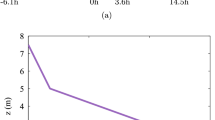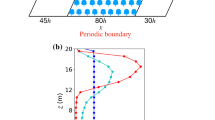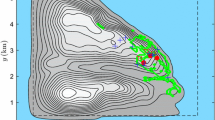Abstract
The structure of turbulent flows along a transition between tall-forested canopies and forest clearings continues to be an active research topic in canopy turbulence. The difficulties in describing the turbulent flow along these transitions stem from the fact that the vertical structure of the canopy and its leaf area distribution cannot be ignored or represented by an effective roughness length. Large-eddy simulation (LES) runs were performed to explore the effect of a homogeneous variation in the forest leaf area index (LAI) on the turbulent flow across forest edges. A nested grid numerical method was used to ensure the development of a deep boundary layer above the forest while maintaining a sufficiently high resolution in the region close to the ground. It was demonstrated that the LES here predicted first-order and second-order mean velocity statistics within the canopy that agree with reported Reynolds-Averaged Navier–Stokes (RANS) model results, field and laboratory experiments. In the simulations reported here, the LAI was varied between 2 and 8 spanning a broad range of observed LAI in terrestrial ecosystems. By increasing the forest LAI, the mean flow properties both within the forest and in the clearing near the forest edge were altered in two fundamental ways: near the forest edge and into the clearing, the flow statistical properties resembled the so-called back-facing step (BFS) flow with a mean recirculation zone near the edge. Another recirculation zone sets up downstream of the clearing as the flow enters the tall forest canopy. The genesis of this within-forest recirculation zone can be primarily described using the interplay between the mean pressure gradients (forcing the flow) and the drag force (opposing the flow). Using the LES results, a simplified analytical model was also proposed to explain the location of the recirculation zone inside the canopy and its dependence on the forest LAI. Furthermore, a simplified scaling argument that decomposes the mean velocity at the outflow edge into a superposition of ‘exit flow’ and BFS-like flow with their relative importance determined by LAI was explored.
Similar content being viewed by others
References
Albertson JD (1996) Large-eddy simulation of Land–Atmosphere Interaction. Ph.D. thesis, university of California Davis, 185 pp
Albertson JD, Parlange MB (1999a) Surface length scales and shear stress: implications for land–atmosphere interaction over complex terrain. Water Resour Res 35: 2121–2132
Albertson JD, Parlange MB (1999b) Natural integration of scalar fluxes from complex terrain. Adv Water Resour 23: 239–252
Albertson JD, Katul , Wiberg P (2001) Relative importance of local and regional controls on coupled water, carbon, and energy fluxes. Adv Water Resour 24(9–10): 1103–1118
Amiro BD (1990) Comparison of turbulence statistics within 3 Boreal forest canopies. Boundary-Layer Meteorol 51: 99–121
Antonia RA, Luxton RE (1974) Characteristics of turbulence within an internal boundary layer. In: Frenkiel FN, Munn RE (eds) Turbulent diffusion in environmental pollution (Adv. Geophys. 18A). Academic Press, pp 263–285
Armali F, Durst F, Pereira JCF, Schonung B (1983) Experimental and theoretical investigation of backward facing step flow. J Fluid Mech 127: 473–496
Asner GP, Jonathan MO, Hicke JA (2003) Global synthesis of leaf area index observations: implications for ecological and remote sensing studies. Global Ecol Biogeogr 12(3): 191–205
Bergen JD (1975) Air movement in a forest clearing as indicated by smoke drift. Agric Meteorol 15: 165–179
Canuto C, Hussaini MY, Quarteroni A, Zang TA (1988) Spectral methods in fluid dynamics. Springer Verlag, Berlin, 557 pp
Cassiani M, Radicchi A, Giostra U (2005) Probability density function modelling of concentration in and above a canopy layer. Agric For Meteorol 133: 153–165
Cassiani M, Radicchi A, Albertson JD (2007a) Modelling of concentration fluctuations in canopy turbulence. Boundary-Layer Meteorol 122(3): 655–681
Cassiani M, Radicchi A, Albertson JD, Giostra U (2007b) An efficient algorithm for scalar PDF modelling in incompressible turbulent flow; numerical analysis with evaluation of IEM and IECM micro-mixing models. J Comp Phys 223(2): 519–550
Chen JM, Clack TA, Novak MD, Adams RS (1995) A wind tunnel study of turbulent airflow in forest clear cuts. In: Coutts MP, Grace J (eds) Wind and Trees, Chap. 4. Cambridge University Press, London
Chun KB, Sung HJ (1998) Visualization of a locally-forced separated flow over a backward-facing step. Exp Fluids 25: 133–142
Dejoan A, Leschziner MA (2004) Large-eddy simulation of periodically perturbed separated flow over a backward-facing step. Int J Heat Fluid Fl 25: 581–559
Deardorff JW (1970) A numerical study of three-dimensional turbulent channel flow at large Reynolds numbers. Investigations of neutral and unstable planetary boundary layers. J Fluid Mech 41: 453–465
Deardorff JW (1972) Numerical investigations of neutral and unstable planetary boundary layers. J Atmos Sci 29: 91–115
Detto M, Katul GG, Siqueira MB, Juang J-Y, Stoy P (2007) The structure of turbulence near a tall forest edge: the backward facing step flow analogy revisited. Ecol Appl (in press)
Dwyer MJ, Patton EG, Shaw RH (1997) Turbulent kinetic energy budgets from a large-eddy simulation of airflow above and within a forest canopy. Boundary-Layer Meteorol 84: 23–43
Ellsworth DS, Oren R, Huang C, Phillips N, Hendrey RH (1995) Leaf and canopy responses to elevated CO2 in a pine forest under free-air CO2 enrichment. Oecologia 104: 139–146
Flesch TK, Wilson JD (1999) Wind and remnant tree sway in forest cutblocks. I. Measured winds in experimental cutblocks. Agric For Meteorol 93: 229–242
Furuichi N, Hachiga T, Kumada M (2004) An experimental investigation of a large-scale structure of a two-dimensional backward-facing step by using advanced multi-point LDV. Exp Fluids 36: 274–281
Garratt JR (1990) The internal boundary layer: a review. Boundary-Layer Meteorol 50: 171–203
Germano M (1992) Turbulence: the filtering approach. J Fluid Mech 238: 325–336
Germano M, Piomelli U, Moin P, Cabot WH (1991) A dynamical subgrid-scale eddy viscosity model. Phys Fluids A 3(7): 1760–1765
Gullbrand J, Chow FK (2003) The effect of numerical errors and turbulence models in large-eddy simulations of channel flow, with and without explicit filtering. J Fluid Mech 495: 323–341
Holland JZ (1989) On pressure-driven wind in deep forests. J Appl Meteorol 28: 1349–1355
Irvine MR, Gardiner BA, Hill MK (1997) The evolution of turbulence across a forest edge. Boundary-Layer Meteorol 84: 467–496
Judd MJ, Raupach MR, Finnigan JJ (1996) A wind tunnel study of turbulent flow around single and multiple windbreaks. 1. Velocity fields. Boundary-Layer Meteorol 80(1–2): 127–165
Kaltenbach HJ (1997) Cell aspect ratio dependence of anisotropy measures for resolved and subgrid scale stresses. J Comput Phys 136(2): 399–410
Katul GG, Albertson JD (1998) An investigation of higher-order closure models for a forested canopy. Boundary-Layer Meteorol 89(1): 47–74
Katul GG, Chang WH (1999) Principal length scales in second-order closure models for canopy turbulence. J Appl Meteorol 38: 1631–1643
Katul GG, Leuning R, Kim J, Denmead OT, Miyata A, Harazono Y (2001) Estimating CO2 Source/Sink distributions within a rice canopy using higher-order closure models. Boundary-Layer Meteorol 98: 103–125
Katul GG, Mahrt L, Poggi , Sanz C (2004) One and two equation models for canopy turbulence. Boundary-Layer Meteorol 113: 81–109
Katul GG, Porporato A, Nathan R, Siqueira M, Soons MB, Poggi D, Horn HS, Levin SA (2005) Mechanistic analytical models for long-distance seed dispersal by wind. Amer Nat 166: 369–376
Khanna S, Brasseur JG (1997) Analysis of Monin-Obukhov similarity from large-eddy simulation. J Fluid Mech 345: 251–286
Klaassen W (1992) Average fluxes from heterogeneous vegetated regions. Boundary-layer Meteorol 58: 329–354
Kostas J, Soria J, Chong MS (2002) Particle image velocimetry measurements of a backward-facing step flow. Exp Fluids 33: 838–853
Kosovic B (1997) Subgrid-scale modelling for the large-eddy simulation of high-Reynolds-number boundary layers. J Fluid Mech 336: 151–182
Laurence W (2004) Forest–Climate interactions in fragmented tropical landscapes. Phil Trans Roy Soc London 359: 345–352
Lesieur M, Metais O, Comte P (2005) Large-eddy simulation of turbulence. Cambridge University Press, Cambridge, 219 pp
Li Z, Lin JD, Miller DR (1990) Air flow over and trough a forest edge: steady state numerical simulation. Boundary-Layer Meteorol 51: 179–197
Liu J, Chen JM, Black TA, Novak MD (1996) E-ε modelling of turbulent air flow downwind of a model forest edge. Boundary-Layer Meteorol 77: 21–44
Mason PJ, Thomson DJ (1987) Large-eddy simulations of the neutral-static-stability planetary boundary layer. Quart J Roy Meteorol Soc 113(476): 413–443
Mason PJ, Thomson DJ (1992) Stochastic backscatter in large-eddy simulation of boundary layer. J Fluid Mech 242: 51–78
Meyers TP, Baldocchi DD (1991) The budgets of turbulent kinetic-energy and Reynolds stress within and above a deciduous forest. Agric For Meteorol 53: 207–222
Moeng CH (1984) A large-eddy simulation model for the study of planetary boundary-layer turbulence. J Atmos Sci 41: 2052–2062
Moin P, Reynolds WC, Ferziger JH (1978) Large-eddy simulation of incompressible turbulent channel flow. Dept. Mech. Eng. Stanford Universiy, Rep. TF-12
Morse AP, Gardiner BA, Marshall BJ (2002) Mechanisms controlling turbulence development across a forest edge. Boundary-Layer Meteorol 103: 227–251
Nakagawa H, Nezu I (1987) Experimental investigation on turbulent structure of a backward facing step flow in an open channel. J Hydraul Res 25: 67–88
Nathan R, Katul GG, Horn HS, Thomas SM, Oren R, Avissar R, Pacala SW, Levin SA (2002) Mechanisms of long-distance dispersal of seeds by wind. Nature 418: 409–413
Nezu I (2005) Open-channel flow turbulence and its research prospect in the 21st century. J Hydraul Eng 131: 229–246
Orlandi P (2000) Fluid flow phenomena. Kluwer Academic Publisher, Dordrecht, 356 pp
Orszag SA, Pao YH (1974) Numerical computation of turbulent shear flows. Adv Geophys 18A: 224–236
Panton R (1984) Incompressible flows. John Wiley and Sons, New York, 779 pp
Patton EG, Shaw RH, Judd MJ, Raupach MR (1998) Large-eddy simulation of windbreak flow. Boundary-Layer Meteorol 87: 275–306
Patton EG, Davis KJ, Barth MC, Sullivan PP (2001) Decaying scalars emitted by a forest canopy: a numerical study. Boundary-Layer Meteorol 100: 91–129
Poggi D, Porporato A, Ridolfi L, Albertson JD, Katul GG (2004) The effect of vegetation density on canopy sublayer turbulence. Boundary-Layer Meteorol 111: 565–587
Porte-Agel F, Meneveau C, Parlange MB (2000) A scale dependent dynamic model for large-eddy simulation: application to a neutral atmospheric boundary layer. J Fluid Mech 415: 261–284
Piirto M, Saarenrinne P, Eloranta H, Karvinen R (2003) Measuring turbulence energy with PIV in a backward-facing step flow. Exp Fluids 35: 219–236
Rao KS, Wyngaard JC, Cote OR (1974) The structure of the two- dimensional internal boundary layer over sudden change of surface roughness. J Atmos Sci 31: 738–746
Raupach MR, Bradley EF, Ghadiri H (1987) Wind tunnel investigation into the aerodynamic effect of forest clearing of the nesting of Abbott’s Booby on Christmas Island. Progress Report, CSIRO Division of Environmental Mechanics, GPO Box 821, Canberra, ACT 2601, Australia, Canberra
Raynor GS (1971) Wind and temperature structure in a coniferous forest and a contiguous field. Forest Sci 17: 351–363
Sagaut P (2002) Large-eddy simulation for incompressible flows. Springer Verlag, Berlin, 426 pp
Scarano F, Benocci C, Riethmuller ML (1999) Pattern recognition analysis of the turbulent flow past a backward facing step. Phys Fluids 11: 3808–3818
Scotti A, Meneveau C, Lilly DK (1993) Generalized smagorinsky model for anisotropic grids. Phys Fluids 5(7): 2306–2308
Schram C, Rambaud P, Riethmuller ML (2004) Wavelet based eddy structure deduction from a backward facing step flow investigated using particle image velocimetry. Exp Fluids 36: 233–245
Schmidt RH, Schumann U (1989) Coherent structure of the convective boundary-layer derived from large-eddy simulations. J Fluid Mech 200: 511–562
Shaw RH, Patton EG (2003) Canopy element influences on resolved- and subgrid scale energy within a large-eddy simulation. Agric For Meteorol 115: 5–17
Shaw RH, Schumann U (1992) Large-eddy simulation of turbulent flow above and within a forest. Boundary-Layer Meteorol 61: 47–64
Shen SH, Leclerc MY (1997) Modelling the turbulence structure in the canopy layer. Agric For Meteorol 87: 3–25
Sheu TWH, Rani HP (2006) Exploration of vortex dynamics for transitional flows in a three-dimensional backward-facing step channel. J Fluid Mech 550: 61–83
Simpson R (1989) Turbulent boundary layer separation. Ann Rev Fluid Mech 21: 205–234
Spazzini PG, Iuso G, Onorato M, Zurlo N, Cicca GMD (2001) Unsteady behaviour of backfacing step flow. Exp Fluids 30: 551–561
Su HB, Shaw RH, Paw U KT, Moeng CH, Sullivan PP (1998) Turbulent statistics of neutrally stratified flow within and above a sparse forest from large-eddy simulation and field observations. Boundary-Layer Meteorol 88: 363–397
Su HB, Shaw RH, Paw U KT (2000) Two-point correlation analysis of neutrally stratified flow within and above a forest from large-eddy simulation. Boundary-Layer Meteorol 94: 423–460
Smagorinsky J (1963) General circulation experiments with the primitive equations. I: the basic experiment. Mon Wea Rev 91(3): 99–165
Sullivan PP, McWilliams JC, Moeng CH (1996) A grid nesting algorithm for large-eddy simulation of planetary boundary-layer flows. Boundary-Layer Meteorol 80: 167–202
Watanabe T (2004) Large-eddy simulation of coherent turbulence structures associated with scalar ramps over plant canopies. Boundary-Layer Meteorol 112: 307–341
Wilson JD, Ward DP, Thurtell DW, Kidd GE (1982) Statistics of atmospheric turbulence within and above a corn canopy. Boundary-Layer Meteorol 24: 495–519
Wilson JD, Flesch TK (1999) Wind and remnant tree sway in forest cutblocks. III. A windflow model to diagnose spatial variation. Agric For Meteorol 93: 259–282
Xie Z, Voke PR, Hayden P, Robins GA (2004) Large-eddy simulations of turbulent flow over rough surface. Boundary-Layer Meteorol 111: 417–440
Yang B, Raupach MR, Shaw RH, Paw KT, Morse A (2006a) Large-eddy simulation of turbulent flow across a forest edge. Part I: flow statistics. Boundary-Layer Meteorol 120: 377–412
Yang B, Morse A, Shaw RH, Paw U KT (2006b) Large-eddy simulation of turbulent flow across a forest edge. Part II: momentum and turbulent kinetic energy budget. Boundary-Layer Meteorol 121: 433–457
Author information
Authors and Affiliations
Corresponding author
Rights and permissions
About this article
Cite this article
Cassiani, M., Katul, G.G. & Albertson, J.D. The Effects of Canopy Leaf Area Index on Airflow Across Forest Edges: Large-eddy Simulation and Analytical Results. Boundary-Layer Meteorol 126, 433–460 (2008). https://doi.org/10.1007/s10546-007-9242-1
Received:
Accepted:
Published:
Issue Date:
DOI: https://doi.org/10.1007/s10546-007-9242-1




